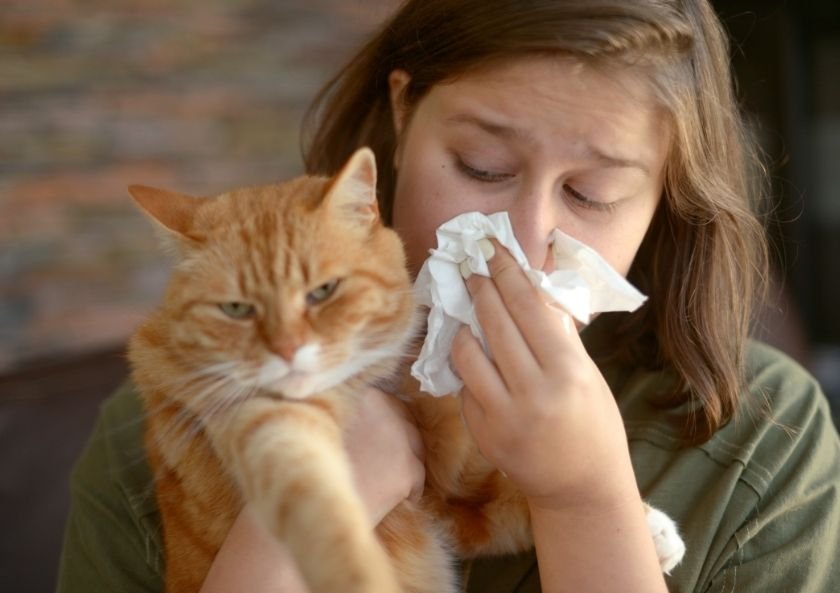Pet allergy is a condition that occurs as an abnormal immune reaction / response when a pet cat or dog comes into contact with its fur, skin, or saliva. The higher the exposure and the greater the number of pets, the higher the likelihood of an allergic reaction.
Who Gets Pet Allergies?
Pet allergies can occur in both children and adults. Individuals of all ages can be affected, regardless of gender. All racial and ethnic groups are equally vulnerable to this situation.
Some people have a higher risk than others. Risk factors for pet allergies include:
- Having pets in the house that include dogs, cats and other animals (rabbit, mouse, squirrel or horse); As the number of pets increases, so does the risk.
- Playing, hugging, kissing and maintaining regular physical contact with pets; the more time spent with them, the higher the risk
- Pets who have access to indoors (including bedrooms), especially areas that are not well ventilated.
- An associated family history of allergies
- Having one form of allergy puts another at risk.
It is important to note that being a risk factor does not mean the allergy will be certain. Someone with a risk factor is more likely to develop an allergy than someone without a risk factor. Some risk factors are more important than others. Also, not having a risk factor does not mean that a person will not have an allergy. It is always important to discuss the impact of risk factors with your doctor.
Which Animals Can Cause Allergies?
Pets such as dogs and cats are the most common allergy-causing species, but animal species such as birds, rodents (hamsters, guinea pigs, gerbils, mice) can also cause symptoms. Cat allergies are twice as common as dog allergies. Products made with feathers, such as some pillows and duvets, can also trigger allergies.
People with dog allergies may be more sensitive to some dog breeds than others. Some people may be allergic to all dogs. “Non-allergic” dog and cat breeds are popular. People may think that some dog breeds are “hypoallergenic,” but there really isn’t a dog or cat that’s not allergic.
Diagnosis in Pet Allergy
Doctors diagnose pet allergies with a simple skin or blood test. In some cases, doctors use reported evidence as evidence of pet allergies. For example, if you own a particular animal species and have hives, your doctor may diagnose pet allergies.
Pet allergy diagnosis may include:
- Physical examination, evaluation of symptoms and medical history evaluation (family history of allergies)
- Skin prick (allergy) test:
- For this test, a very small amount of specific substance is injected under the skin (forearm, upper arm or back).
- If, after 15-20 minutes, the spot where the chemical was injected swells or there is a rash, then this indicates that the person may be allergic to the substance.
- Blood test to detect antibodies (IgE antibody test)
Many clinical conditions can have similar signs and symptoms. Your doctor may perform additional tests to rule out other clinical conditions to make a definitive conclusion.
Symptoms and Treatment in Pet Allergy
Allergy symptoms may occur when you are near your pet or soon after. In most cases, pet allergy symptoms include:
- Itchy, watery eyes
- Sneeze
- Runny nose
- Stuffy nose
- Itchy skin
- Itching in the mouth and throat
- Cough
- Raised red spots on the skin (hives)
- Asthma symptoms such as chest tightness, difficulty breathing, or wheezing
Animal allergy symptoms are similar to those caused by other allergens such as pollen, dust or mold. Many of these symptoms, such as sneezing and runny nose, can also be caused by illnesses such as the flu or a cold. Your doctor will help pinpoint the cause of your symptoms.
Pet allergy treatment can be done as follows:
- Avoiding further exposure to pet dogs, cats or other animals
- Anti-allergic drugs for mild reactions; antihistamine therapy prescribed by an allergist
- Symptomatic therapy; use of decongestants, especially for nasal block, including steroid sprays, use of eye ointments for eye symptoms
- Respiratory support when needed to control asthma symptoms and low blood pressure
- Asthma, wheezing, etc. bronchodilators for respiratory conditions
- Applying appropriate treatment for underlying lung infections or diseases
- In case of anaphylaxis (severe allergic reaction), epinephrine or adrenaline is administered immediately.
- Immunotherapy (allergy vaccines) in case of severe allergies for long-term development of tolerance
Pet Allergy Prevention Methods
It may not be possible to prevent pet allergy, but the situation can be minimized with the following steps:
- If allergic to pets, keep them away as much as possible, minimize contact with them
- Limit pets’ access to areas: Avoid allowing pets to roam throughout the house; don’t let them get inside their bedrooms
- Avoid kissing or hugging pets; don’t let them lick you on your face or nose
- Wash hands thoroughly with soap and water after contact with pets, especially before eating.
- Avoid touching your face or inadvertently rubbing your eyes after physical contact with pets.
- Give pets regular baths (at least once a week)
- Trim pet hair and nails as needed
- Get regular vaccinations (as recommended by your veterinarian)
- Regularly clean indoors, fur and other animal secretions; use high-powered vacuum cleaners on room rugs, mattresses and sofas
- Use better efficiency air conditioning filters (such as HEPA filters)
- Keep your outdoor gardens properly cleaned and maintained; mow the lawn regularly, cut tall and weeds
In addition, the following may be considered:
- Studies have shown that children breastfed for 4-6 months or more can help them develop body immunity and be less prone to allergies.
- Proper maternal diets during pregnancy can help develop stronger resistance (to allergies) in children.



